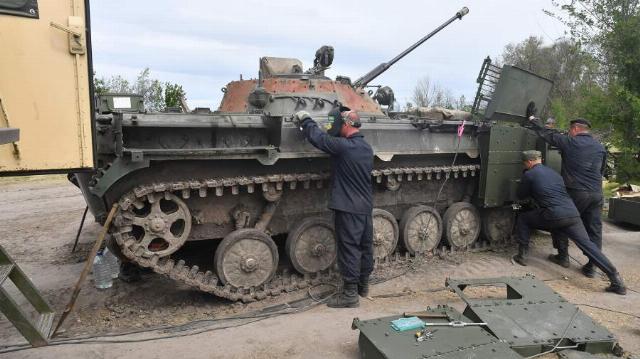The new equipment will reduce the time for repair and maintenance of equipment
The troops have 3D printers for printing large components for vehicles and armored vehicles. They can produce parts of various sizes and configurations directly in the field. This will significantly reduce the time for repair and maintenance of equipment, since troops will be less dependent on the supply of parts. In addition, 3D printing technologies will come to the rescue if you need a spare part of a non-standard format, experts say.
The troops have 3D printers for printing large components for vehicles and armored vehicles. They can produce parts of various sizes and configurations directly in the field. This will significantly reduce the time for repair and maintenance of equipment, since troops will be less dependent on the supply of parts. In addition, 3D printing technologies will come to the rescue if you need a spare part of a non-standard format, experts say.
What are 3D printers for in army repair units?
3D printers capable of printing parts of various sizes, including relatively large ones, have appeared on the equipment of repair units of the Russian troops, sources told Izvestia in the military department. They were included in the composition of mobile vehicles for maintenance and repair of automotive equipment. This concept includes special machines, workshops and equipment necessary for servicing vehicles in the field.
— With the help of 3D printing technologies, it is possible to quickly produce some relatively simple spare parts directly in the repair department. This should significantly reduce the time for repair and maintenance — you do not need to wait until all the necessary components are supplied," the sources said. — You can print from various materials, including rubber, composite, elastic plastic. The technology allows you to quickly produce, in particular, panels for mounting power electrical equipment of armored vehicles or, for example, engine gaskets.
In a combat zone, 3D printers will be indispensable, as they will help repair units gain time, which solves a lot in real combat conditions, military expert Yuri Lyamin told Izvestia.
"For ammunition or reinforcements that are not delivered on time, you often have to pay with the lives of soldiers and officers, disruption of important combat missions," he explained. — To prevent this from happening, the equipment must always be kept in working condition. And it's not that easy, especially in real combat conditions. The supply of spare parts may be delayed due to infrastructure damage, fuel problems, changes in the situation, and then the logistics of delivery.
The expert recalled that there are two types of 3D printers - working with plastic parts and metal ones.
"All of them are needed," he noted. — Plastic parts wear out quickly. A printer working with metal will allow you to produce a large range of important parts in the field. This will enhance the workshops' capabilities. There is never a complete set of spare parts anywhere, so printers should help solve the problem of their shortage.
Sometimes it is necessary to install an exclusive part with non-standard parameters on damaged equipment, an associate professor of the Russian University of Economics told Izvestia. Plekhanova, Colonel Alexander Perendzhiev.
— It happens that during the repair, not quite a universal part is needed, a specific one, — he noted. — For example, there have been some shifts in the mechanism, changes after damage. It is not always advisable to install a standard part. Of course, 3-D printing technology makes it possible to quickly simulate an exclusive detail that is needed in a particular case, to make a kind of military tuning machine. In this case, she will act no less effectively than before the defeat. With non-standard parts, it is very difficult to resolve the issue during repair: you need to send an application to the factory, wait for them to figure out how to make this part. There is nothing better to come up with than using three-dimensional printers. This is a good way out for the fastest commissioning of equipment. And in some cases, it will be able to become even more effective than before it received damage.
The advantage of Russian equipment over Western equipment is its suitability for field repair
Earlier, the deputy head of the Main Armored Personnel Carrier Directorate (GABTU) of the Ministry of Defense, Major General Sergei Shalenyi, said that one of the main disadvantages of Western equipment supplied to Ukraine is that it can only be repaired at stationary production bases.
— We have a large number of stuck cars, a large number of cars that the enemy cannot evacuate himself. The complexity of their device involves repair only at stationary production bases. Accordingly, there is no military repair, their rapid return to service. There is no question about it at all. Now we see very few of these vehicles on the line of contact. Because they are out of order and require repair," he noted.
Unlike Western equipment, Russian vehicles are repaired directly by the troops, and only for particularly difficult repairs they are sent to stationary bases. Each motorized rifle or tank regiment has a repair company, and the corresponding divisions have repair and restoration battalions. They have everything you need for machine maintenance and repair work.
Recently, the military department has been actively introducing innovations in the rear infrastructure. As previously reported by Izvestia, in particular, a mobile refueling station has been developed for the troops. This is a special container that is installed on an all-terrain truck. It provides compartments for a generator, an electric motor, a gas tank, spare parts, tools and fire extinguishers. When creating it, the experience of its own was studied and taken into account. If necessary, it can be removed from the car and installed on a prepared site or in a caponier. For this purpose, the container is equipped with hydraulic loading and unloading devices and parking supports.

